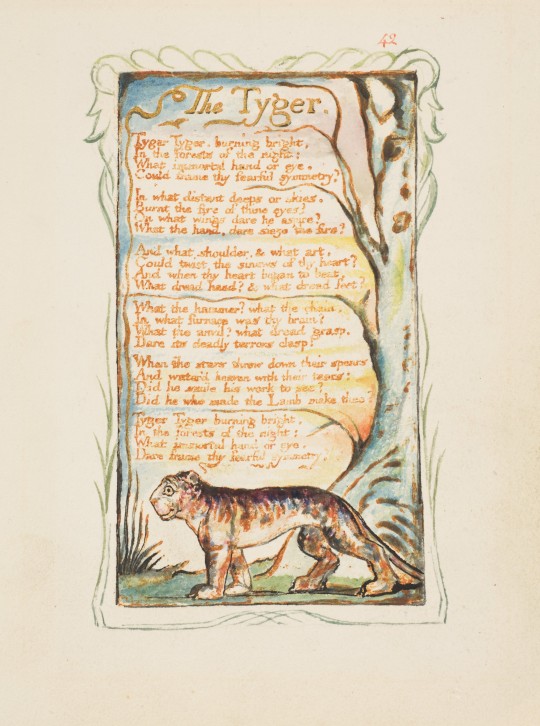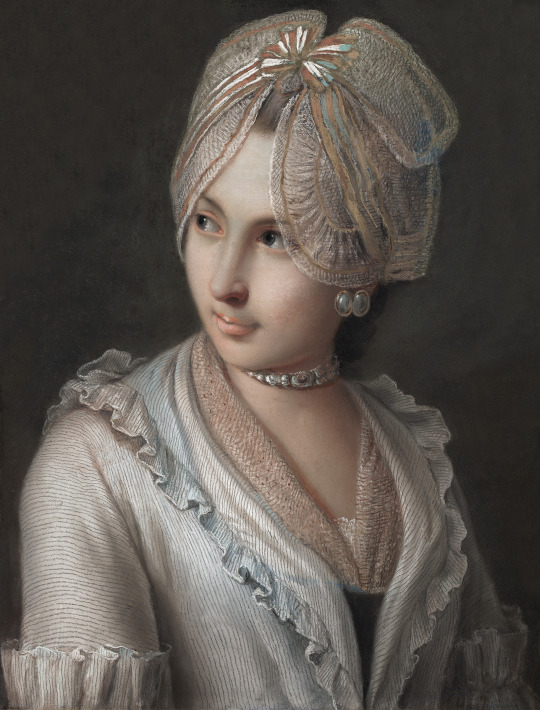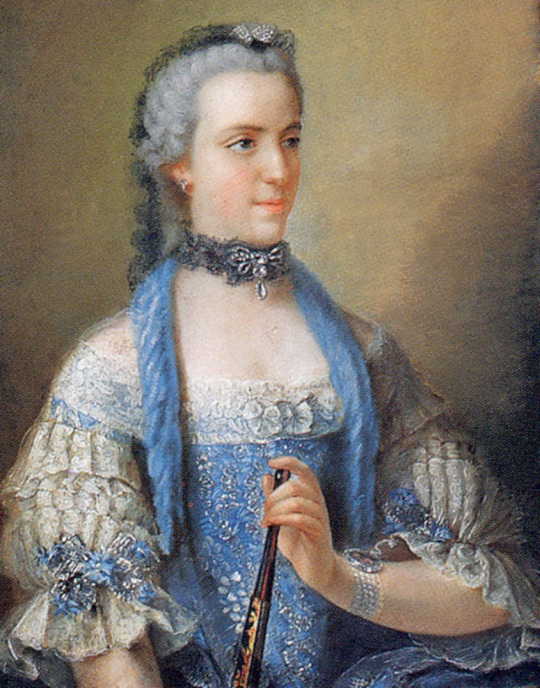#ca. 1757
Text

جيوفاني باولو بانيني: رسام ومهندس إيطالي من القرن الثامن عشر، ميز نفسه كأول رسام متخصص في الآثار، وعلى وجه الخصوص الرسوم الجذابة لأطلال روما. تتجلى خبرته في اللوحات البانورامية الرومانية التي تظهر عظمة المدينة.
على لوحة قماش كبيرة، صوّر بانيني معرضاً دقيقاً تظهر فيه المعالم الأثرية والمنحوتات القديمة الشهيرة من داخل روما وما حولها. نرى أيضاً بعض الشخصيات مظهرين إعجابهم بدليل إرشادي بالقرب من جدارية جصية لزفاف ألدوبرانديني.
نستطيع رؤية معالم مميزة كالبانثيون وكولوسيوم وعمود تراجان، وتمثال هرقل الرخامي الذي نراه أيضاً هنا يُظهِرُ تقديره الكبير لتراث المدينة الخالدة.
كان الممول لهذا العمل الكونت دي ستاينفيل (الذي أصبح لاحقاً: الدوق دي شوازول). نراه وسط اللوحة ودليل في يده. وضع بانيني نفسه في اللوحة أيضاً، نجده خلف الكرسي في موضع يظهر فيه رفعة مقام راعيه مقارنة بمقامه.
قدرة بانيني الفريدة على تجسيد روح روما القديمة تركت علامة فارقة سمحت للمتفرجين برؤية لمحة من رونق الماضي من خلال رؤيته الفنية. توجد بعض نسخ من هذه اللوحة في : متحف شتوتغارت في برلين، واللوفر في باريس.
Ancient Rome
Giovanni Paolo Panini
ca. 1757
1 note
·
View note
Text
A Powder Horn With Fine Engraved Decoration by John Bush (ca. 1725–1757)
In 2021 the Department of Arms and Armor acquired a powder horn with fine engraved decoration by the hand of John Bush (ca. 1725–1757), one of the first major engravers of the Lake George school and the only Black American known to have decorated powder horns. By contrast, his works have long been admired for the original style and graceful execution of their ornamentation and are highly regarded…

View On WordPress
#A Powder Horn With Fine Engraved Decoration#A Powder Horn With Fine Engraved Decoration by John Bush (ca. 1725–1757)#African American Art#African American history#African Art#African artifact#Black American art#Black American History#John Bush
0 notes
Text

Vladímir Lukich Borovikovsky (Russian, 1757-1825)
St. Luke the Evangelist, ca.1804
#saint luke the evangelist#christian art#christian#christianity#christentum#catholic#catholic art#catholicism#art#fine art#european art#classical art#europe#european#fine arts#oil painting#europa#mediterranean#russian art#russia#russian#Vladímir Lukich Borovikovsky#Vladimir Lukich Borovikovsky#Vladímir Borovikovsky#Vladimir Borovikovsky#halo#saint#sainthood#patron saint#1800s
205 notes
·
View notes
Text

José Segrelles - Caronte. Canto II de la Divina Comedia (ca. 1929)
Segrelles’ output achieved great success, particularly his illustrations for stories, tales and fables.
With a restless and idealistic spirit, the painter instilled a sense of mysticism and symbolism into his compositions, drawing the reader into a fantastic and dream-like world that was the perfect accompaniment to the texts he illustrated. Strange actions, terrifying visions, torments, magical beings… in other words: exaltations of the imagination of an artist who, by inflaming the sublime, brings to mind the work of Johann Heinrich Füssli (1741—1825) and of the painter and poet William Blake (1757—1827).
This drawing is part of the series of eight watercolours Segrelles made to illustrate Dante’s Divine Comedy, a commission from the Araluce publishing house in the late 1920s. The quality of this body of work won him a Gold Medal at the 1929 Barcelona International Exposition.
The work in hand represents Charon, the Greek mythological character whose job was to ferry souls in his boat through the Marsh of Acheron to the underworld on the other side of the river of the dead. In payment, the souls had to give him one Obol, which is why it was the custom to put a coin in the mouth of the dead when burying them. Segrelles’ depiction of the ferryman is rather disquieting: an old man with big bulging eyes, his mouth half-open and a long white beard. His face brings to mind a phantasmagorical being, with eyes and gaping mouth reminiscent of that of a snake to provoke fear and anxiety. In short, a hybrid character, half way between a man and a strange being from the depths of the sea. (source)
96 notes
·
View notes
Text

William Blake (1757-1827) — The Angel of Apocalypse [watercolour and ink, ca. 1805]
327 notes
·
View notes
Text

Antonio CANOVA (1757 – 1822) - Tête de Calliope ou Portrait présumé de Marie-Louise de Habsbourg, Impératrice des Français en Calliope, ca. 1812
45 notes
·
View notes
Text
youtube
Fortunato Chelleri (ca. 1690–1757) - Amalasunta: Aria. La navicella ·
Adèle Charvet · Le Consort
19 notes
·
View notes
Text
Jean-Baptiste Masse (ca. 1700 - ca. 1757) - Sonata for Cello and Basso continuo in a-minor, Op. 1 No. 3, II. Vivace. Performed by Hidemi Suzuki, cello, and Ricercar Consort on period instruments.
#jean baptiste masse#baroque#classical music#cello#cellist#period performance#period instruments#cello sonata#sonata#chamber music#baroque music#rarely performed composers#strings
36 notes
·
View notes
Note
Top 5 Graveses!
My Deer Friend, that is a fun ask!
Samuel "Sam" Graves (1713-1787). Tough on the outside, very soft on the inside, his personality has captured my research interest. Often portrayed as a nepotistic old choleric (which to some degree he was) in especially older literature on the American Revolutionary War, the man below the public persona of the admiral was the exact opposite. A caring man who appears to have been well liked by his sailors and the local people near his home, he was surprisingly open-minded when it came to what we might call women's rights, the importance of giving your children an education (something he openly chastised his brother about in letters, finding his nephews had not received enough schooling), and by all I was able to learn about the family, very good with young people. His personal tragedy was that he was childless due to a medical complication he was aware of, but he filled this void with his brother John's children and his second wife Margaret's orphaned niece, Elizabeth, who would take very much after Samuel, developing an interest in technology and ships. What never fails to strike me is how he helped protect Elizabeth's best friend Mary Anne, who may fall under the term queer, given she stated during her lifetime that she had no interest in men, from a forced marriage.
Margaret Graves (1728-1808). "Mrs Admiral", feared by many, loved ardently by her husband. So much so that rumour had it that it was she who wore the trousers in their relationship. A tough lady who was independently wealthy and had never planned on marrying at all to remain in control of her fortune, it took her all of ca. 6 months to decide that she wanted Samuel by her side permanently. She was by all accounts difficult, outspoken to the point of often deliberate rudeness, and one of the first bluestockings, being a frequent visitor to Elizabeth Montagu's London salon. In her sixties, she caused a stir in Bath for dancing at balls, which was frowned upon due to her age. She did not care.
John Graves Simcoe (1752-1806). Is it cheating? I don't think so. But he was named for Samuel Graves, and called "Infant Graves" by the same in a letter written to young Simcoe's father around the time of John Graves' christening. I found the Graves' through Simcoe, when many years ago I watched Turn: Washington's Spies and mostly remained watching on account of the delightfully evil ginger menace, John Graves Simcoe. The question "he can't have been that bad, can he?" (spoiler: he was absolutely not, rater the opposite, really) led to a research rabbit hole that ended with me finding out about Simcoe's supportive quasi-family which he found in his godfather Samuel, who helped raise him from the time he lost his father at age seven on, and supported his godson well into his thirties. Samuel viewed him as part of the family, and therefore, he can make this list!
Jane Graves (1666-1767). The mother of Samuel and his siblings, her own life appears to have been quite interesting from what little information we have. She seems to have married comparatively late, and to a significantly younger man at that; she was 46 or 47 when Samuel, her youngest, was born. When her husband died, she must have cared for Samuel's inheritance, and raised her son by herself. Looking at her life span alone, she must have been a very interesting person to talk to, given she lived to 100 or 101, a period spanning from the year of the Great Fire of London to the year the Townshend Acts were passed and Joachim Murat was born.
Richard "Dick" Graves (1757-1836). The enfant terrible of the family, living largely off his uncle's benevolence and will to promote him in the Navy. Badly educated, bad with money and so spectacularly bad with women that Elizabeth, his uncle's niece by his wife, loathed to even be in the same room as him (which ended Samuel's hope of getting the two involved with each other). "Dick" as the family called him with very likely the same undertone as in the famous Jane Austen quote on the late naval officer Dick Musgrove in Persuasion, had so little going for himself that the family sincerely hoped he would marry a rich woman, as that was his only chance of finding a settled life. He was, as they called it "shown" around at social events for that purpose. He did manage to bag an heiress, but their life together was unhappy, full of finanical struggles as both spent more money than they had, and assorted fights with Aunt Mrs Admiral, the Simcoes, the Admiralty and other assorted people. He even agreed to be the second in a duel once, while also being a Justice of the Peace. He must have been a troublesome man, but somehow strikes me as a little interesting for that matter.
#ask reply#ask game#samuel graves#margaret graves#elizabeth posthuma simcoe#john graves simcoe#jane graves#richard graves#18th century#history
12 notes
·
View notes
Text
For #InternationalTigerDay 🐅 on #Caturday:

William Blake (British, 1757–1827)
"The Tyger"
Songs of Innocence and Experience (copy Y), plate 42
Date: [1794] printed ca. 1825
Relief etching printed in orange-brown ink and hand-colored with watercolor and shell gold
6 3/16 x 5 9/16 in. (15.7 x 14.1 cm)
Metropolitan Museum of Art, New York 17.10.42
>One of Blake's best-known verses, "The Tyger," comes from the Songs of Innocence and of Experience. Blake originally produced this small, richly illustrated collection of short lyric verses as two separate books, in 1789 and 1794, then combined them into a single volume in the latter year. Although its small, colorful format recalls a children's book, its message is sophisticated and complex. Innocence and Experience contrast human existence, before and after the Fall. The pastoral poems in Innocence express religious faith and acceptance, and exhibit fine detail and flowing lines; the bardic verses in Experience, by contrast, convey disillusionment and anger, and employ bolder outlines. Published during the height of the Terror, the French Revolution left its mark on the second book.
Blake produced only twenty-four copies of the combined volume; this page comes from one of the last, prepared about 1825 for the painter and printmaker Edward Calvert (1799–1883). Its deep, saturated hues and distinctive ornamental borders (found on only one other copy) contrast with the lighter, paler colors of editions printed three decades earlier. The book remained in the Calvert family until the late nineteenth century; in 1917, it became the first work purchased for the Metropolitan Museum's new Department of Prints by its distinguished first curator, William M. Ivins, Jr.<
#animals in art#18th century art#19th century art#William Blake#The Tyger#British art#European art#book art#book illustration#illustration#print#Metropolitan Museum of Art New York#tiger#feline#Caturday#International Tiger Day#animal holiday
34 notes
·
View notes
Text


26. Stronghold - Summoning (Black Metal, 1999)
Art by John Martin: "The Bard", ca 1817 - adapted for the album
"John Martin’s version of "The Bard" unites the drama of the poem by Thomas Gray, published in 1757, with a vision of sublime landscape."
#metal#black metal#landscape#john martin#river#summoning#austria#painting#art#artwork#oil painting#artist
74 notes
·
View notes
Text

▪︎ Lear Grasping a Sword (Illustration to Shakespeare).
Artist: William Blake (English, 1757–1827)
Date: ca. 1780
Medium: Pen and watercolor on paper
45 notes
·
View notes
Text

Vladimir Lukich Borovikovsky (Russian, 1757-1825)
Our Lady, ca.1814-15
State Tretyakov Gallery, Moscow
#Vladimir Lukich Borovikovsky#Russian art#russia#russian#our lady#1800s#art#fine art#european art#classical art#europe#european#oil painting#fine arts#europa#mediterranean#painting#artwork#christian art#christian#christianity#christentum#catholic#bible#catholicism#western civilization#catholic art
290 notes
·
View notes
Text
Esoterica

I° esposizione internazionale d'arte decorativa, Torino, 1902 (Collezione Soleri, Torino) | Leonardo Bistolfi (1859-1933, Italia) |

La Superbia (Mira qui come va senza ritegno la cecitade humana al cieco regno), 1679 (British Museum) | Giovanni Maria Mitelli (1634-1718, Italia)

Pornocratès - La dame au cochon, 1896 (Musée Félicien Rops, Namur, Belgium) | Félicien Rops (1833-1898, Belgium) et Albert Bertrand (1852-1912, France)

Los Proverbios, 1817-23 | Francisco Goya (1746-1828, España)

Surreal nude with candle - occult photo, 1950's |cph., Zoltán Glass (1903-1982, Hungary)

Jacobs Dream, 1805 | William Blake (1757-1827, England)

Carnevale | Italico Brass (1870-1943, Italia)

The joyous festival, 1906 ca. | Gaston La Touche (1854-1913, France)

Clouds, Lauterbrunnen Valley, 1901 | Charles Giron (1850-1914, Switzerland)

I cavalieri della nebbia (the knights of the fog), 1896 | Albert Welti

Fairies dances in the woods with faun on gramophone, 1925

Idolo nero (idole noire), 1903 | Frantisek Kupka (1871-1957, Czechia)

The path of silence, 1903 | Frantisek Kupka (1871-1957, Czechia)

Nymphs dancing to Pan's flute | Joseph Tomanek (1889-1974, Czechia - USA)

Oberon, Titania and Puck with fairies dancing, 1786 | William Blake (1757-1827, England)

s/t (w/t), 1975 (Sanok Museum, Poland) | Zdzisław Beksinki (1929-2005, Poland)

AA72, 1972 | Zdzisław Beksinki (1929-2005, Poland)

Dance on the beach, 1900-02 | Edvard Munch (1863.1944, Swedev)

Summer, 1890's | Thomas Wilmer Dewing (1851-1938, USA)

Summer evening, 1947 | Edward Hopper (1882-1967, USA)
6 notes
·
View notes
Photo






1750s portraits -
Top Elizabeth Dunch, later Lady Oxenden, by Thomas Hudson (auctioned by Christie's). From Wikimedia 793X1024.
Second row left 1750-1756 Elegant Young Lady with a Lace Cap by Pietro Rotari ( location ?). From tumblr.com/fashionsfromthepast; fixed spots & some flaws w Pshop 1826X2400.
Second row right Woman, possibly Isabella of Parma by ? (location ?). From tumblr.com/la-reinette; fixed bigger spots & flaws w Pshop 844X1076.
Third row left 1757 (before) Lady attributed to Donat Nonnotte (Auktionhaus Stahl - Nov2012 auction Lot 4). From liveinternet.ru/users/4248621/post473220149/; all parts blurred more or less except eyes,flowers, & fan 1683X2048 @300 696kj.
Third row right 1758 Aristocratic Lady by Johann Heinrich Tischbein the Elder (private collection), From tumblr.com/history-of-fashion/704055816368668672/1758-johann-heinrich-tischbein-the-elder730X965.
Fourth row ca. 1759 (see auction notes) Mary Stopford (1736-1810), Countess of Courtown by Sir Joshua Reynolds (auctioned by Sotheby's). From tumblr.com/sims4rococo76 2048X2734.
#1750s fashion#Rococo fashion#Louis XV fashion#Georgian fashion#Elizabeth Dunch#Thomas Hudson#feathered hat#modesty pice#square décolletage#neckline ruff#full skirt#pietro rotari#cap#bow#fichu#lace veil#wavy hair#lace neck band#lace bertha#lace ruffled sleeves#Donat Nonnotte#neck band#stomacher#three-quarter length sleeves#engageantes#V waistline#robings#gloves#Johann Heinrich Tischbein the Elder#hair flowers
21 notes
·
View notes
Note
1757 U-U it think- or was it 1756? -ca
damn youre goodd at this hmmm
0=2(x+5)^2-18 solv for x there are two ansers
2 notes
·
View notes